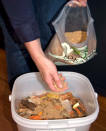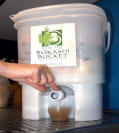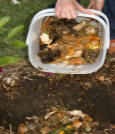USING THE BOKASHI BUCKET.
The Bokashi Bucket is a practical and convenient alternative for transforming kitchen waste intoa nutrient rich soil conditioner. This unique composting system uses the revolutionary Micro-Organism Bokashi to enable airtight (anaerobic) composting, without the odours
associated with rotting food.
STEP BY STEP Guide to using a Bokashi Bucket
Place your food scraps in the bin, no more than a 3-4cm thick layer.
If you have more scraps than that, simply go through the process again.
You can compost most kitchen food waste including fresh fruit and vegetables, prepared foods,
cooked and uncooked meats and fish, cheese, eggs, bread, coffee grinds, teabags, wilted flowers
and tissues.
then cover evenly with approximately one handful of Bokashi.
Add extra Bokashi with high protein foods such as meat, fish, cheese and eggs.
Press down to remove air after every application. Tip: Use a plastic bag or a potato masher.
Ensure that the lid is closed tightly. Why: The fermentation process works best without oxygen.
Drain the Bokashi Juice that has accumulated in the bottom of the bucket. Tip: use as liquid
fertilizer, see FAQs below.
Keep layering food scraps and Bokashi until the bucket is full.
When the bucket is full, top it up with a generous layer of Bokashi and let the contents ferment for a period of 10-14 days at room temperature, continuing to drain off the Bokashi Juice regularly.
While this full bucket of waste is fermenting, you can begin the process again in a second Bokashi bucket.
Dig a hole or trench approximately 20-25 cm deep.
Add your fermented Bokashi Compost and mix in some soil. Cover with remaining soil.
For established gardens, dig the holes around shrubs or between rows of trees.
Once the fermentation period is over, you will see that the food looks similar to pickles. TheBokashi Bucket composting process has been a success if it smells similar to pickles or cider
vinegar. Occasionally, particularly after longer fermentation periods, a white cotton-like fungi
growth may appear on the surface. This shows that a good fermentation process has occurred.
HELPFUL TIPS for using a Bokashi Composting System
FAQsWhat can I put in my Bokashi Bucket ?
You can compost most kitchen food waste including fresh fruit and vegetables, prepared foods,cooked and uncooked meats and fish, cheese, eggs, bread, coffee grinds, teabags, wilted flowers
and tissues.
What can’t I put in the Bokashi Bucket?
Do not put liquids (water, milk or fruit juice), paper and plastic wrap, or meat bones into theBokashi Bucket.
How do I know my Bokashi is ready to use?
Bokashi Compost will look different to compost that has decayed in a compost bin. The food wastedoes not break down while it is in the bucket, so much of its original form will remain and it
will have a pickled appearance. The waste will breakdown completely a few weeks after it has been
transferred to the soil.
What does Bokashi do for my garden?
Burying Bokashi Compost in the garden will supply the plants with a nourishing food source andcondition your soil with enriching microbes. The Bokashi Bucket composting system significantly
accelerates the composting process of organic waste. Bokashi Compost is acidic when first dug in,
but neutralizes after 7-10 days. Be sure plant roots do not come directly into contact with the
compost as it may burn the roots, particularly if the plants are very young. Fresh compost can be
stressful to new plants so it is best to wait two weeks before planting you favourite veggies,
flowers etc.
How do I use Bokashi Compost?
Dig a hole or trench approximately 20-25 cm deep. Add your fermented Bokashi Compost and mix insome soil. Cover with remaining soil. For established gardens, dig the holes around shrubs or
between rows of trees.
If you have don’t have space to dig a new hole every time you empty your bucket, you can create a“Bokashi compost heap” by burying a large bottomless plastic bucket with a good lid (30 litres
and above is ideal) up to its neck. Mix a little soil to each batch of Bokashi Compost that you
place into the bucket.
Can I use Bokashi in planter boxes?
You can use your Bokashi Compost in planter boxes, tubs or pots by placing it directly into thecontainer for further fermentation. Fill 1/3 of the container with potting mix (new or used) then
add the Bokashi Compost and mix with soil. Fill the remaining 1/3 of the container with potting
mix and cover with a plastic bag to maintain anaerobic conditions. Wait two weeks before planting
you favourite veggies or flowers, or transfer potting mix into smaller pots for planting.
My Bokashi looks and smells bad, what do I do?
Bokashi should not have a strong rancid or rotten smell, and there should not be black or blue-green fungi.To fix these problems:
Why is my Bokashi juice a different colour?
The amount and colour of the Bokashi Juice produced will depend on the type of foods you have putinto the Bokashi Bucket.
Why is my Bokashi bucket not producing any liquid?
Moist foods such as fruit and veggie scraps will result in more juice, but it is not essential toproduce liquid.
What can I use the Bokashi Juice for?Bokashi Juice can be used:
In the Garden –To fertilise an existing garden or pot plants use 1 teaspoon to 2-3
litres of water and apply directly to the soil. For trees and shrubs use 2 teaspoons to 2-3
litres of water. Do not apply directly to foliage.
Around the House – Pour the concentrated Bokashi Juice directly into your kitchen and
bathroom drains, toilets or septic systems. The micro-organisms will help to
prevent algae build-up and control odour. It will also help to clean up our waterways by
competing with harmful bacteria.
Bokashi Juice cannot be stored and must be used within 24 hours after draining from the bucket .



